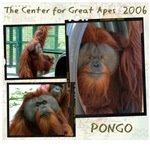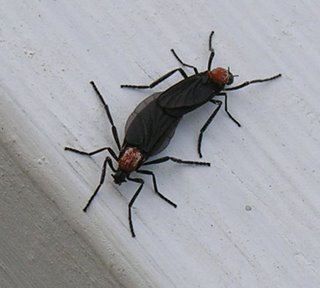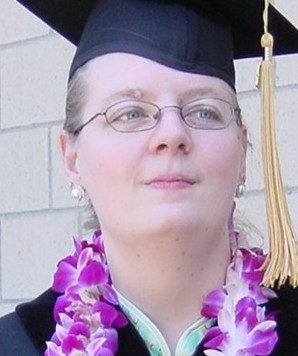Lovely Weather and Long PCR
The weather here is just lovely. It's still warm enough for a t-shirt everyday and I have yet to turn on my heat. I hear from other people that it is "cold" where they live, but I just can't relate anymore. Today has been the first day that it feels like autumn. It was such a nice day that I played hookey this afternoon and went for a quick hike. [10.24.06 addendum - it was 36F this morning!]
Paynes Prairie State Preserve is just a few miles from campus and parking is free! The preserve has an usual geology due to the underlying limestone structures. Sometimes it's a large lake, other times it is a grassland. Apparently there was one point when the limestone sinkholes became plugged and the lake became large enough to support steamboat traffic. And then the sinkholes opened back up and the lake drained within a week. Or so the story goes. My first time hiking there I was lucky enough to see the herd of wild "cracker horses". These are supposedly descendants of the horses brought over by the Spanish settlers. There is also a herd of bison that was brought to the preserve about 20 years ago, but I haven't seen them yet. The hiking trail that I normally use passes through a woodland area and then opens up onto the "prairie" component. At the end of the trail there is a small observation platform. Today when I reached the platform, there was a vulture sitting on the railing. He flew away when I approached, but he left behind the remains of the fish he had been working on. Very interesting! Mark, it would have been nice to have you along to help identify all of the different birds.
Non-biology people may want to skip this paragraph as it will probably make no sense. Today is my first attempt at a "long" (10kb) PCR. Stratagene recommends an extension time of 2 min/kb, so that means the program is quite lengthy. We only have one thermocycler in this lab and I'm a little nervous about having to repeat the PCR if I don't have any product. I'm still getting used to culture conditions here. Fermentations are usually done with at least 9% carbon source, as opposed to the 0.2% that I used back at UCLA. As you can imagine, we go through glucose and xylose very quickly. We actually buy xylose in 50-lb bags.
The rumor around the lab is that there was a snake in our building on Friday night. Very scary! I've always kept an eye out for rats after the infestation that we had at UCLA, but I wasn't aware that I should be watching for snakes here.
I bought Moulin Rouge and Trainspotting this weekend, both very original movies. The Moulin Rouge soundtrack is actually playing on my computer right now. Somewhat suprisingly, Trainspotting is in the top 250 movies on IMDB, near "Toy Story" and "Magnolia".
Many people are saying that the new TV show "Heroes" is very good. I haven't given in to temptation yet. On Monday nights I'm usually too busy watching re-runs of "Six Feet Under" on Bravo. Who all is watching Heroes and why do you like it?
There's not much else new or exciting going on here. Officially, I'm spending all of my non-work time working on writing up my results from my PhD work. I'm planning on getting an ipod and would appreciate any comments that anyone has to offer regarding the various models.
Paynes Prairie State Preserve is just a few miles from campus and parking is free! The preserve has an usual geology due to the underlying limestone structures. Sometimes it's a large lake, other times it is a grassland. Apparently there was one point when the limestone sinkholes became plugged and the lake became large enough to support steamboat traffic. And then the sinkholes opened back up and the lake drained within a week. Or so the story goes. My first time hiking there I was lucky enough to see the herd of wild "cracker horses". These are supposedly descendants of the horses brought over by the Spanish settlers. There is also a herd of bison that was brought to the preserve about 20 years ago, but I haven't seen them yet. The hiking trail that I normally use passes through a woodland area and then opens up onto the "prairie" component. At the end of the trail there is a small observation platform. Today when I reached the platform, there was a vulture sitting on the railing. He flew away when I approached, but he left behind the remains of the fish he had been working on. Very interesting! Mark, it would have been nice to have you along to help identify all of the different birds.
Non-biology people may want to skip this paragraph as it will probably make no sense. Today is my first attempt at a "long" (10kb) PCR. Stratagene recommends an extension time of 2 min/kb, so that means the program is quite lengthy. We only have one thermocycler in this lab and I'm a little nervous about having to repeat the PCR if I don't have any product. I'm still getting used to culture conditions here. Fermentations are usually done with at least 9% carbon source, as opposed to the 0.2% that I used back at UCLA. As you can imagine, we go through glucose and xylose very quickly. We actually buy xylose in 50-lb bags.
The rumor around the lab is that there was a snake in our building on Friday night. Very scary! I've always kept an eye out for rats after the infestation that we had at UCLA, but I wasn't aware that I should be watching for snakes here.
I bought Moulin Rouge and Trainspotting this weekend, both very original movies. The Moulin Rouge soundtrack is actually playing on my computer right now. Somewhat suprisingly, Trainspotting is in the top 250 movies on IMDB, near "Toy Story" and "Magnolia".
Many people are saying that the new TV show "Heroes" is very good. I haven't given in to temptation yet. On Monday nights I'm usually too busy watching re-runs of "Six Feet Under" on Bravo. Who all is watching Heroes and why do you like it?
There's not much else new or exciting going on here. Officially, I'm spending all of my non-work time working on writing up my results from my PhD work. I'm planning on getting an ipod and would appreciate any comments that anyone has to offer regarding the various models.




